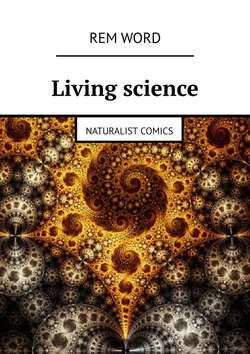Living science. Naturalist Comics

Реклама. ООО «ЛитРес», ИНН: 7719571260.
Оглавление
Rem Word. Living science. Naturalist Comics
Light is faster than light
Measure the speed of light. At home
The world in a new light
Energy is coming back. Is always
Guns instead of power stations?
Eternal Engine DIY
Metal laser
Life lines
Similarities feel each other at a distance. Now it’s science
Unusual properties of radio waves
Let’s fly?
The formation of science. Physics. What’s next?
Biology and Mathematics
Отрывок из книги
From the science known to us, taught in schools and universities, the mysterious, now similar to religion or magic, its peak has flown away. It happened in the first half of the twentieth century. … First of all, some scientists introduce the sly position that particles of light do not have their own rest mass. These corpuscles themselves lose the status of the actual, material formations and are henceforth called “pure energy.” And this is all despite the fact that energy is an abstract meaning, only the ability of the body to do a certain work. This state of affairs seeks to present A. Einstein’s Special and General Theories of Relativity formulated at the beginning of the twentieth century. A rather weighty basis for creating theories of STR and GR, it should be noted, is available. This is a very curious behavior of light. Firstly, its speed, as if, is always the same. It is equal to the constant C – 300 thousand kilometers per second. Even when the source moves towards the observer. The principle of arithmetic addition of speeds does not work here. If it were otherwise, the starry sky, for example, would seem to us a set of luminous lines, not points. Stars move rather quickly, and turn around their axis. If their own speed were transmitted to particles of light, accelerated or delayed photons, arriving at an observer on Earth sooner or later, they would blur the image of the star into a broad line. Is this the reason for the statement of SRT: “The speed of light is constant, does not depend on the movement of the source,” and all mental constructions emanating from this?
Probably, photons having a speed other than C exist. A lot of them. However, their method of registration should be different. The Mössbauer effect is known. Two crystals cooled to almost absolute zero, with atoms almost stopped, are not able to exchange gamma quanta (“hard light”), if they only begin to move relative to each other at some speed (several centimeters per second). Quanta fly through the crystal without finding an atom with a suitable absorption spectrum. Look at the picture. As soon as the absorber of quanta (in this case, the source, anyway) begins to move, hard photons pass through it and are recorded by the detector.
.....
We return to the stars. Yes, we do not see these celestial bodies as luminous segments, or more precisely, the optical similarities of comets due to the fact that the speed of light is limited only by the limited intersection of the emission-absorption lines in our eyes and in the matter of stars. Otherwise, for example, the “flying” star Barnard, which moves across the sky to the diameter of the moon for 170 years, would definitely look tail-shaped. But – we must look more carefully. Perhaps artificially created ideas about the finiteness of the speed of light make it difficult for astrophysicists and astronomers to notice a certain blurring of stars (and especially binary stars) in the course of their movement.
One of the author’s long-standing experiences is the scanning through of a rotating semi-transparent disk. The photographs show that, closer to its edge, where the linear velocity is higher, the screen becomes more transparent (while with a fixed disk, the illumination is uniform). The higher the mutual speed of the light source and obstacles, the lower the probability of the screen absorbing “non-standard” quanta. Thus, the Mössbauer effect is manifested not only in the sterile conditions of first-class laboratories, exclusively with frozen crystals and gamma quanta, but also on the Kulibin table, and everywhere in our lives. 1. A translucent textolite disk capable of rotating with a linear speed of the rim of 10 ms. 2. The projection of a spot of light transmitted through the disk. 3. A stream of light passing through the disk (for clarity, it is shown rotated 90º). 4. A lamp creating a stream of light 5. A tube with a lamp 6. A stationary platform with a tube 7. A stream of light passing through a certain oval area. 8. Photo material – photo paper, or photographic film (in this case, a camera obscura is used to obtain a clear projection of the spot). 9. Directly, the translucent area of the disk. 10. The electric motor rotating a disk. 11. The spot area, which becomes lighter when the disc is rotated. 12. The spot area (closer to the center, where the screen speed is less), in comparison with the distance from the axis, is darkened.
.....